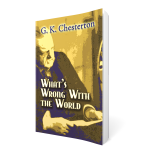Who are Hudge and Gudge, and why are they important to us?
Chesterton introduced these two in his 1910 book, What’s Wrong with the World. Both Hudge and Gudge were gentlemen of the governing class. Gudge was described as a plutocrat, a Tory, an individualist, and perhaps a slumlord. Hudge was described as a socialist, an idealist, a progressive, and perhaps a vegetarian.
In short, these are none other than the political antagonists we know as the Liberal (Hudge) and the Conservative (Gudge). But there was an important third individual in Chesterton’s discourse, and his name was Jones. He was not a gentleman of the governing class but merely a member of the lower orders of society, the common family man.
The key to Chesterton’s politics is that he refused to take part in the debate between Hudge and Gudge, but rather judged them both by the test of Jones. What, he asked, had Gudge, the industrial-capitalist, done to strengthen the family of Jones? What had Hudge, the socialist-idealist, done to strengthen the family of Jones?
Gudge rules by a coarse and cruel system of sacking and sweating and bi-sexual toil, which is totally inconsistent with the family and is bound to destroy it. And Hudge calls a women’s work freedom to live her own life, and says the family is something we shall soon gloriously outgrow.
Gilbert Keith Chesterton says to measure current issues and political proposals by the test of Jones. By that standard, the governing classes of Chesterton’s day and our own have failed miserably, as both Hudge and Gudge continue their separate and ferocious attacks on the family of Jones.

